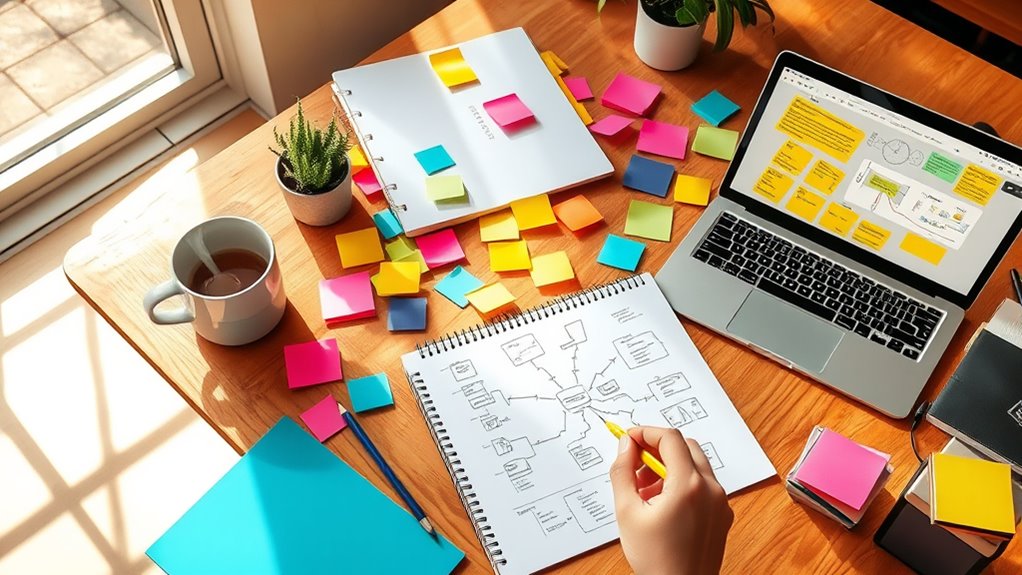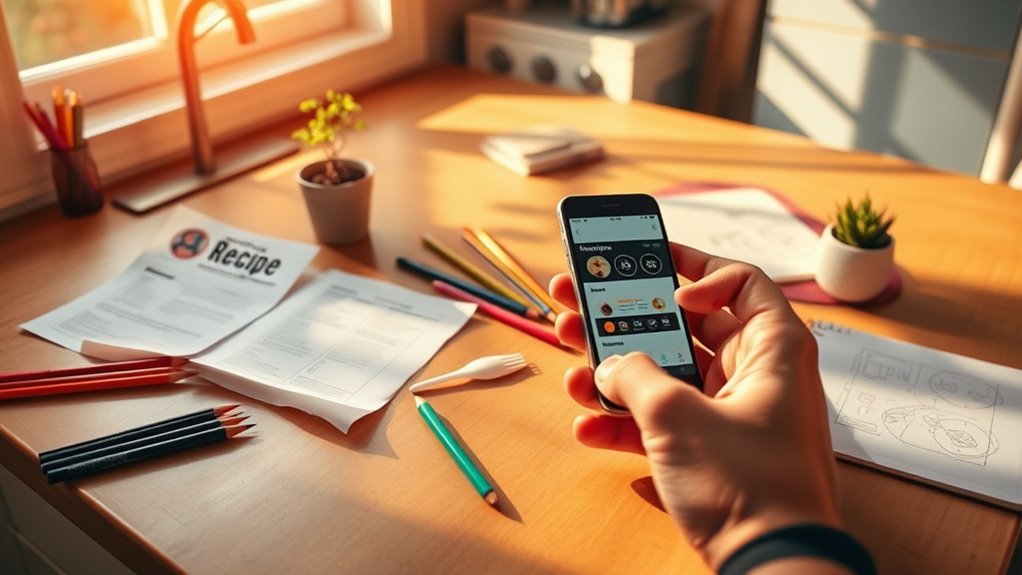To tackle everyday problems with creativity, try combining brainstorming and mind mapping. Start by jotting down every idea that comes to mind without judging them, encouraging free thinking. Then, organize those ideas visually into a mind map to see connections and uncover solutions more easily. Developing a flexible mindset helps you explore alternatives and build resilience. Keep exploring these techniques to turn daily challenges into opportunities for growth and innovation.
Key Takeaways
- Use brainstorming to generate diverse ideas without judgment, fostering innovative solutions for daily challenges.
- Create mind maps to visualize problems and uncover connections, making complex issues easier to resolve.
- Combine brainstorming and mind mapping for comprehensive exploration and organized problem analysis.
- Develop a flexible mindset by exploring multiple options and embracing out-of-the-box thinking.
- Practice resilience by viewing obstacles as opportunities for growth and applying creative strategies consistently.

Have you ever faced a tough problem and wondered how to find an innovative solution? When you’re stuck, it’s easy to feel overwhelmed or frustrated. That’s where creative problem-solving strategies come into play, helping you approach challenges with fresh perspectives. One effective method is using brainstorming techniques. These techniques encourage you to generate numerous ideas without immediately judging their feasibility. By setting aside your inner critic and focusing on quantity, you often stumble upon unexpected solutions. For example, you might jot down every idea that comes to mind, no matter how outlandish it seems. This process opens your creativity and opens up possibilities you might not have considered.
Another powerful tool to enhance your problem-solving is mind mapping. Imagine your problem at the center of a page, with branches radiating outward representing different ideas or potential solutions. Mind mapping helps you visualize connections between thoughts, making complex problems more manageable. It stimulates your brain to think in patterns, linking related concepts and uncovering new angles. As you expand your map, you might see solutions emerging naturally from the relationships between ideas. This visual approach keeps your focus clear and organizes your thoughts systematically, giving you a holistic picture of the problem and possible routes forward. Additionally, understanding how somatic therapy integrates mind and body awareness can inspire you to approach problems with a more holistic mindset, considering both emotional and physical factors that influence your thinking.
In practice, combining brainstorming techniques with mind mapping can be a game changer. During a brainstorming session, you might quickly jot down ideas, then use a mind map to organize and explore those ideas in depth. This synergy maximizes your creativity and helps you identify the most promising solutions. Whether you’re tackling a work project, planning a family event, or resolving a personal issue, these strategies keep your mind active and engaged. They push you past mental blocks and encourage a mindset of curiosity rather than judgment.
Using these methods also trains your brain to think flexibly. Instead of sticking to conventional solutions, you challenge yourself to explore alternatives. Over time, this habit enhances your ability to adapt and innovate in everyday situations. The key is to stay open-minded and persistent, knowing that the first idea isn’t always the best. By regularly practicing brainstorming and mind mapping, you build a toolkit of creative strategies that become second nature when trouble arises.
Ultimately, the goal isn’t just to solve problems quickly but to develop a mindset that views challenges as opportunities. These techniques empower you to approach difficulties with confidence, knowing you have effective tools to generate ideas and see solutions from new angles. As a result, you become more adept at navigating life’s obstacles with creativity and resilience.
Frequently Asked Questions
How Can I Improve My Creative Thinking Skills Daily?
To improve your creative thinking skills daily, start by practicing mind mapping to organize your ideas visually, which sparks new connections. Incorporate brainstorming techniques like setting a timer or asking “what if” questions to generate fresh ideas. Challenge yourself to think outside the box and stay curious. Consistent practice with these strategies helps you develop a more flexible, innovative mindset, making creative thinking a natural part of your daily routine.
What Are Common Obstacles to Effective Problem Solving?
Imagine trying to see through a foggy window; habitual barriers and cognitive biases block your view, making it hard to find solutions. These obstacles often trip you up—habitual barriers keep you stuck in routines, while biases distort your judgment. Recognizing these limits helps you clear the fog, allowing fresh perspectives. Overcoming these common obstacles is key to solving problems more effectively and creatively every day.
How Do I Stay Motivated When Solutions Take Time?
When solutions take time, you stay motivated by cultivating a perseverance mindset and practicing patience techniques. Remind yourself that progress often comes gradually, so focus on small wins to keep momentum. Break down your goal into manageable steps, celebrate each achievement, and stay committed. Remember, patience and persistence are key—trust that your efforts will pay off, even if it takes a little longer than expected.
Can Creative Strategies Work for Serious or Complex Issues?
Yes, creative strategies can work for serious or complex issues. By applying innovative approaches, you can uncover unique solutions that traditional methods might miss. Focus on practical applications, like brainstorming multiple options or breaking problems into smaller parts. This active, flexible mindset helps you adapt and find effective ways to tackle even the most challenging situations. Embracing creativity boosts your problem-solving power in serious contexts.
What Tools or Apps Assist With Creative Problem Solving?
Think of tools and apps for creative problem solving like a Swiss Army knife—versatile and handy. You can try apps like MindMeister or Miro for brainstorming techniques, helping you visualize ideas. Idea management tools like Evernote or Notion keep your thoughts organized and accessible. These tools boost your creativity, making it easier to generate, capture, and refine solutions efficiently, just like having a well-stocked toolkit for any challenge.
Conclusion
By embracing these creative problem-solving strategies, you’ll find yourself gently steering life’s little challenges with a fresh perspective. Remember, not every obstacle is as daunting as it seems—sometimes, a touch of ingenuity can transform a potential stumbling block into a stepping stone. So, keep an open mind and trust your creative instincts; they’ll guide you through even the most delicate situations with grace and ease. After all, a little ingenuity goes a long way.









